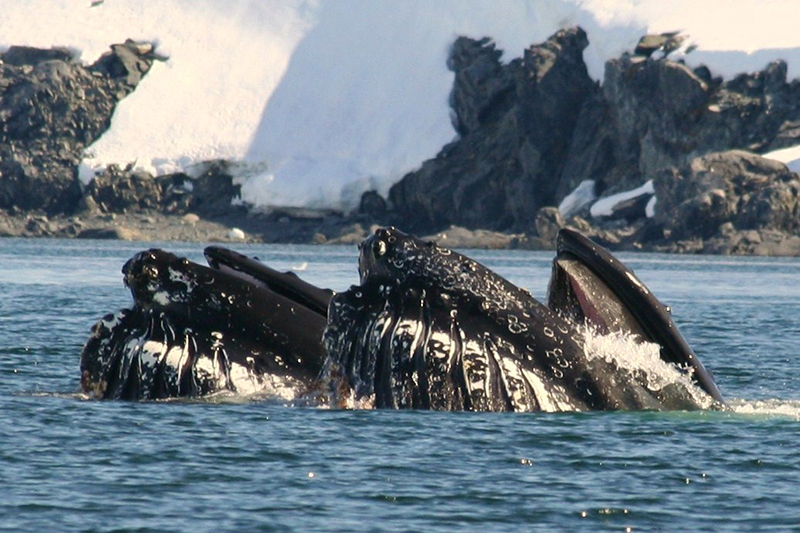 Two thirty-six ton black monsters drive themselves out of the cold, dark waters of the Southern Ocean, ripping the surface into a boiling mess of angry white pandemonium, their mouths wide open as they consume their prey. As the black bodies rise into the freezing air, sea water cascades from plated grooves in the creature’s mouths designed to filter out liquid but trap red fleshed krill, the diet of choice for discerning Humpback Whales like these in front of me. Together with all my fellow passengers, I have my mouth wide open too. In our case in wonderment at the power that would need to be generated by these huge behemoths to propel their gargantuan mass out of the water.
Two thirty-six ton black monsters drive themselves out of the cold, dark waters of the Southern Ocean, ripping the surface into a boiling mess of angry white pandemonium, their mouths wide open as they consume their prey. As the black bodies rise into the freezing air, sea water cascades from plated grooves in the creature’s mouths designed to filter out liquid but trap red fleshed krill, the diet of choice for discerning Humpback Whales like these in front of me. Together with all my fellow passengers, I have my mouth wide open too. In our case in wonderment at the power that would need to be generated by these huge behemoths to propel their gargantuan mass out of the water.
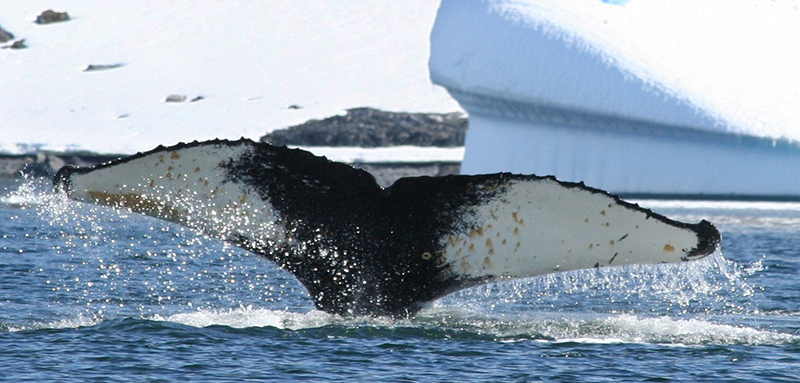 Whales are creatures that have fascinated since time began; Ahab pursued one, Jonah was swallowed by one and nowadays we all want to see them breaching the dark ocean waters. During the early afternoon they are content to laze about near the surface, imitating a large piece of black flotsam, and seem unconcerned if a lucky zodiac full of tourists comes within a few metres.We were magnificently rewarded on two occasions when a humpback came right alongside the ship. If I could have leant over the rails to water level I could have touched it. Up close, they are not pretty beasts being covered in barnacles, but, boy, are they enormous. The ones we saw must have been about 15 metres long, around 2 metres wide and just took up a lot of room. They stayed around for 5 minutes or so before going off for dinner and they had everyone on board scampering about, pushing and shoving, barging for the best camera shots and we all behaved just like a bunch of feral paparazzi.
Whales are creatures that have fascinated since time began; Ahab pursued one, Jonah was swallowed by one and nowadays we all want to see them breaching the dark ocean waters. During the early afternoon they are content to laze about near the surface, imitating a large piece of black flotsam, and seem unconcerned if a lucky zodiac full of tourists comes within a few metres.We were magnificently rewarded on two occasions when a humpback came right alongside the ship. If I could have leant over the rails to water level I could have touched it. Up close, they are not pretty beasts being covered in barnacles, but, boy, are they enormous. The ones we saw must have been about 15 metres long, around 2 metres wide and just took up a lot of room. They stayed around for 5 minutes or so before going off for dinner and they had everyone on board scampering about, pushing and shoving, barging for the best camera shots and we all behaved just like a bunch of feral paparazzi.
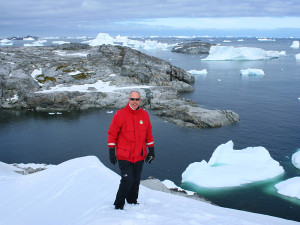 Whale watching is a cold affair. And it can get awfully cold here in the Antarctic. This year is the 30th anniversary of the recording of the coldest temperature on earth, a mere minus 89.2 degrees Celsius. It is difficult to put this into context for us humans (we are, after all, tropical animals not well equipped to deal with mildly cold temperatures) and the best I can do is to point out that at -44C flesh freezes in a minute. Against the cold I am dressed in a thick base layer, then a T shirt, then a windstopper, then a jumper and, finally, a parka. I also have 2 pairs of socks, leggings, trousers and waterproof over trousers. I am OK most of the time, but when the wind blows, I can still get cold to the bone.
Whale watching is a cold affair. And it can get awfully cold here in the Antarctic. This year is the 30th anniversary of the recording of the coldest temperature on earth, a mere minus 89.2 degrees Celsius. It is difficult to put this into context for us humans (we are, after all, tropical animals not well equipped to deal with mildly cold temperatures) and the best I can do is to point out that at -44C flesh freezes in a minute. Against the cold I am dressed in a thick base layer, then a T shirt, then a windstopper, then a jumper and, finally, a parka. I also have 2 pairs of socks, leggings, trousers and waterproof over trousers. I am OK most of the time, but when the wind blows, I can still get cold to the bone.
Fortunately, the boat on which I have travelled here provides thermal jackets that protect us from the cold. It is just one of the many thoughtful comforts laid on for intrepid travellers who come to the White Continent to experience this monochrome land which has captured the imagination of curious explorers, adventure seekers and nature lovers since its discovery.
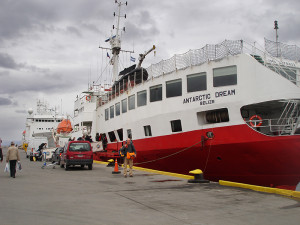 To get here we jumped on a boat departing from Ushuaia (known as ‘El fin del Mundo’ – the end of the world) at the southernmost point of Argentina. The better tour companies begin their itineraries once you arrive in Buenos Aires and guide you down to your boat over a three or four day period. Matilda Dean from Abercrombie and Kent says, “We want our passengers to arrive as relaxed as possible. That way they are going to get the most from this unique experience.” Their ship, Le Boreal, is one of the most luxuriously appointed with a fully operational spa and even a butler service available. More importantly, it has stabilizers to steady the ship in rough waters. It’s impossible to realise just how important these can be when crossing Drake Passage to the Antarctic Peninsula unless your boat doesn’t have them – as mine didn’t – and you end up spending three days drugged up with sea sick pills.
To get here we jumped on a boat departing from Ushuaia (known as ‘El fin del Mundo’ – the end of the world) at the southernmost point of Argentina. The better tour companies begin their itineraries once you arrive in Buenos Aires and guide you down to your boat over a three or four day period. Matilda Dean from Abercrombie and Kent says, “We want our passengers to arrive as relaxed as possible. That way they are going to get the most from this unique experience.” Their ship, Le Boreal, is one of the most luxuriously appointed with a fully operational spa and even a butler service available. More importantly, it has stabilizers to steady the ship in rough waters. It’s impossible to realise just how important these can be when crossing Drake Passage to the Antarctic Peninsula unless your boat doesn’t have them – as mine didn’t – and you end up spending three days drugged up with sea sick pills.
However, when you arrive, any small discomfort undertaken during the journey disappears.The Antarctic Continent is a landmass that holds 90% of the world’s ice and 70% of the world’s fresh water but truly it is a desert having the snow equivalent of less than 3 inches (7 cm) of rain – a precipitation rate close to that of the Sahara Desert – falling over the interior of the continent. But snow and ice have been accumulating on Antarctica for millions of years; more than 15,600 ft (4,800 m) deep at its thickest with a mean depth of ice exceeding 6,500 ft (2,000 m). It is also the highest continent in the world and even the South Pole is at an elevation of 9,301 ft (2,860 m).
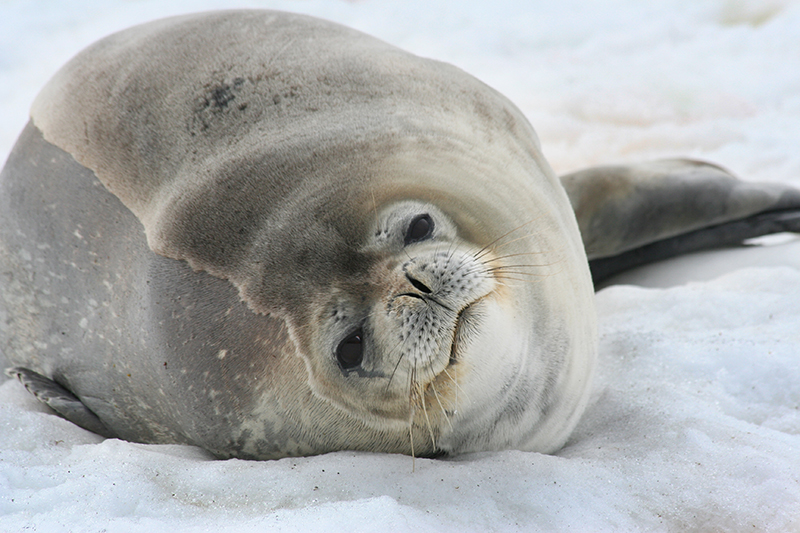 Besides the magnificent whales we saw a number of different species of seals. They are all chunky beasts coated in blubber against the cold but amazingly agile in the water. The leopard seal likes to eat penguin, itself faster under the water than any man can sprint, so these large lumps of lard have to be able to twist and turn with gymnastic contortion or go hungry. By contrast, when they are on land they are slow cumbersome creatures. They laze about semi-somnolent scratching their face and chest with the claws on the end of their front flippers, occasionally lifting their head to observe what we are up to before returning to sleep.
Besides the magnificent whales we saw a number of different species of seals. They are all chunky beasts coated in blubber against the cold but amazingly agile in the water. The leopard seal likes to eat penguin, itself faster under the water than any man can sprint, so these large lumps of lard have to be able to twist and turn with gymnastic contortion or go hungry. By contrast, when they are on land they are slow cumbersome creatures. They laze about semi-somnolent scratching their face and chest with the claws on the end of their front flippers, occasionally lifting their head to observe what we are up to before returning to sleep.
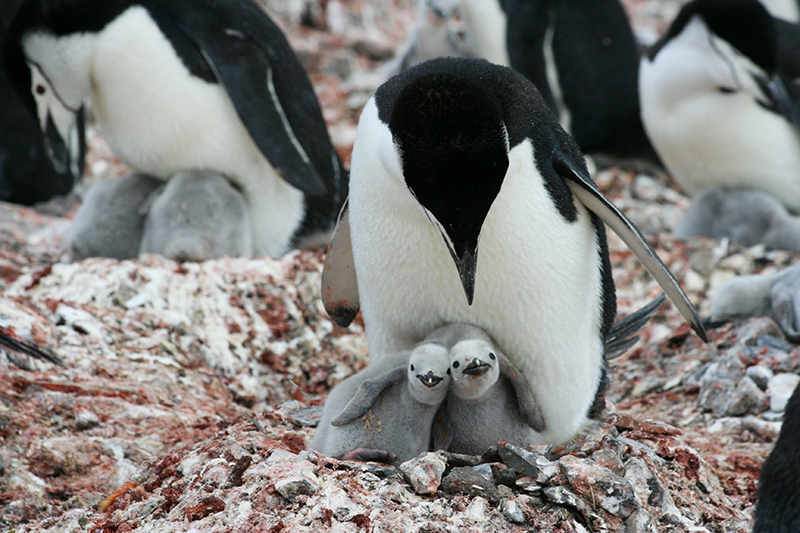 Penguins are not much better on land than the seals. At this time of year the penguins are busy looking after their young who are around 4 weeks old and are just a light grey bundle of fluff, entirely dependent upon their parents for food and shelter (nothing new there). The Penguin colonies themselves are a chaotic mess of nests made from small stones strewn in haphazard fashion over a rocky outcrop. The area is coloured white and red from penguin poo depending upon what they have been eating (white = fish, red = krill) and smells pretty ripe. The penguins have a powerful ejection system for poo and often manage to cover one of their neighbours or a passing friend with the type of eau de cologne that will never sell in the shops. However, none of them seem to object to having their starched shirts splattered and many of our photographs show them heading seawards for a clean up looking as if they are returning from a drunken night on the town.
Penguins are not much better on land than the seals. At this time of year the penguins are busy looking after their young who are around 4 weeks old and are just a light grey bundle of fluff, entirely dependent upon their parents for food and shelter (nothing new there). The Penguin colonies themselves are a chaotic mess of nests made from small stones strewn in haphazard fashion over a rocky outcrop. The area is coloured white and red from penguin poo depending upon what they have been eating (white = fish, red = krill) and smells pretty ripe. The penguins have a powerful ejection system for poo and often manage to cover one of their neighbours or a passing friend with the type of eau de cologne that will never sell in the shops. However, none of them seem to object to having their starched shirts splattered and many of our photographs show them heading seawards for a clean up looking as if they are returning from a drunken night on the town.
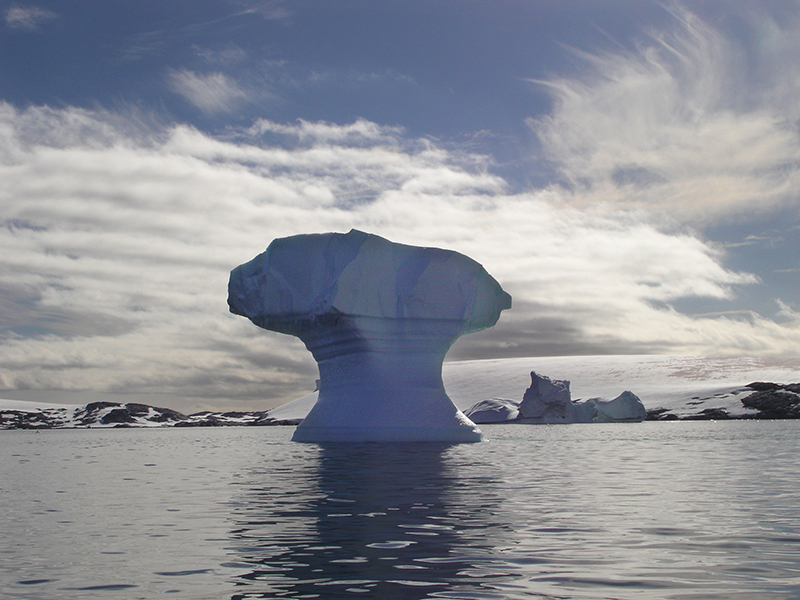 On the water, it is icebergs that litter the landscape. Mostly they are small and often cover the entire surface of the sea in the area that we are sailing but the ship bullies its way through them pushing them aside with little effort. Some are big and we have to avoid them, slaloming our way through channels that are flanked by angry looking black mountains. The larger bergs invariably have fantastic shapes, all of which seem to be entirely unique. The elements had sculpted one to the spitting image of Sydney Opera House and another into a scale model for a modern cathedral. The bergs that are relatively flat topped, and not more than a metre above sea level, typically are populated by different types of seals having a kip during the day between fishing expeditions.
On the water, it is icebergs that litter the landscape. Mostly they are small and often cover the entire surface of the sea in the area that we are sailing but the ship bullies its way through them pushing them aside with little effort. Some are big and we have to avoid them, slaloming our way through channels that are flanked by angry looking black mountains. The larger bergs invariably have fantastic shapes, all of which seem to be entirely unique. The elements had sculpted one to the spitting image of Sydney Opera House and another into a scale model for a modern cathedral. The bergs that are relatively flat topped, and not more than a metre above sea level, typically are populated by different types of seals having a kip during the day between fishing expeditions.
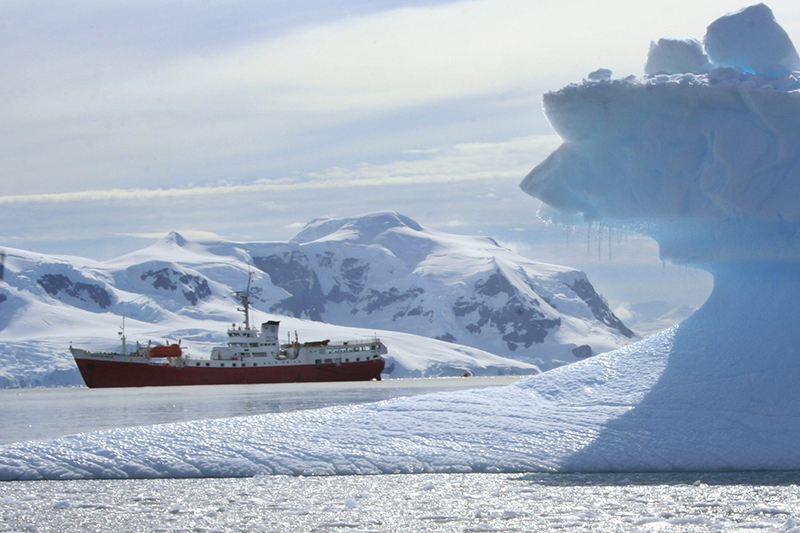 Out trip down some of the channels was truly spectacular. The Lemaire Channel in particular in which the ship feels insignificant as it sails in waters 100 metres wide walled by steep, Hades black mountains and sparkling diamante icefields. When the sun comes out, and we were very fortunate with the weather, all we can do is stand and gawp. It is stark beautiful, cold, uninviting but riveting. We loved it.
Out trip down some of the channels was truly spectacular. The Lemaire Channel in particular in which the ship feels insignificant as it sails in waters 100 metres wide walled by steep, Hades black mountains and sparkling diamante icefields. When the sun comes out, and we were very fortunate with the weather, all we can do is stand and gawp. It is stark beautiful, cold, uninviting but riveting. We loved it.
But it is the whales that I remember most vividly. These magnificent creatures that man has hunted almost to extinction fill us with astonishment and admiration. The more opportunities we can have to encounter them in their natural habitat and learn about their world, the more likely it is that they receive the protection required so as to amaze our great-grandchildren.
Published in Spears magazine
Download the PDF here
